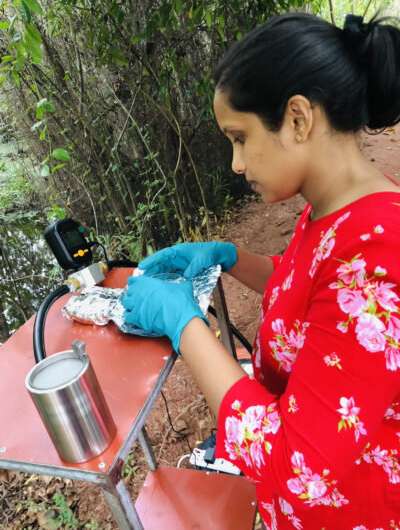This article has been reviewed according to Science X's editorial process and policies. Editors have highlighted the following attributes while ensuring the content's credibility:
fact-checked
peer-reviewed publication
trusted source
proofread
Researchers evaluate levels of indoor microplastics in Australia

Griffith University researchers have taken a forensic look at the amount of airborne microplastics in indoor environments in Australia, and the results are confronting.
Published in Science of The Total Environment, the researchers collected and filtered samples of air from seven indoor environments on the Gold Coast where people spend most of their time, including a childcare center, an office, a school, two homes, a restaurant and a car.
"While all these indoor environments contained airborne microplastic pollution, our results showed that the childcare center was the worst," said lead author Kushani Perera, a Ph.D. candidate from the Australian Rivers Institute.
"Most people spend more time indoors compared to outdoors, so it's important to quantify the amount of airborne microplastics in indoor air to understand human exposure."
In this study, microplastic fibers and fragments ranging from 0.020mm to 5mm in size were sampled across different indoor and outdoor sites of Southeast Queensland.
"Microplastics were detected in all samples, including outdoor air," Perera said. Plastic pollution in indoor samples was much higher than outdoors, and our sample from the childcare center had microplastic concentrations 11 times greater than the sample taken outdoors (2.2 particles per cubic meter compared to 0.2 particles per cubic meter)."
"The office and school both had approximately 5-times outdoor concentrations, while the two homes restaurant were between 2.5 and 4.5 times outdoor levels."
"With these amounts of airborne plastics in indoor environments, our calculations suggest the average Australian male between the ages of 18 and 64 can breathe in more than 3,000 plastic particles every year," Perera said.
Professor Frederic Leusch, a co-author study from the Australian Rivers Institute's Toxicology Research Group said the results can largely be explained by the presence of high plastic-content items indoors, combined with activity levels.
"The largest sources of microplastic pollution are soft textiles, like rugs, carpets, curtains and clothes, which can shed tiny plastic particles that can easily become airborne."
"With the childcare center there's more carpet, there's plastic toys, there's more movement in the room as well with kids running, so it's not surprising that airborne microplastics would be high in such an environment."
Fortunately, Leusch highlighted some simple things that we can do to reduce our exposure to microplastics. "The single biggest thing is to regularly open up your windows and get a good breeze coming in from outside.
"Vacuuming regularly will also help. This is because the microplastics in the air will eventually settle into dust on the floor, so if you only vacuum once a month you may have a large reservoir on the floor that you're re-suspending every time you walk through your house.
"Finally, people need to limit their use of clothes dryers and air conditioners; it's probably the primary source for microplastic particles around the house."
Considering acute, chronic, industrial, and individual susceptibility, more detailed human inhalation exposure levels to airborne microplastics need to be determined for a realistic appraisal of the human health risk, including how much of the inhaled particles are then exhaled?
Perera said more work also was needed to determine if there are any health consequences from the inhalation of thousands of microplastic particles each year.
"Now we understand the different exposure levels, the next step is to culture human lung cells and expose them to the concentrations and types of microplastics we observed in this study and see what adverse biological effect that can have."
More information: Kushani Perera et al, Microplastics in Australian indoor air: Abundance, characteristics, and implications for human exposure, Science of The Total Environment (2023). DOI: 10.1016/j.scitotenv.2023.164292
Journal information: Science of the Total Environment
Provided by Griffith University





















